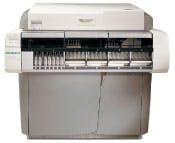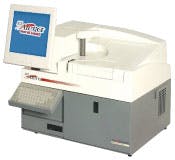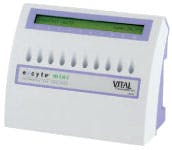Here are their insights.
Galloway: Current pre-analytics focus on reducing
manual tasks, such as moving tubes between stations, centrifugation, and
cap removal. New advances may focus in the areas of further error
reduction and sample quality: for example, technologies that guarantee
correct identification of a sample to a patient ,or that can validate
the right test is being performed on the right tube type, or verify the
integrity of the sample (volume or interferences such as hemolysis or
lipemia) before sending the tube to the analytical engine.
MLO: What advances to the back-end of automated
systems will we be seeing in the future? We have come a long way since
2000 when lab automation was warming up. What about the back-end
automation has been the most important improvement in the ensuing years?
What about it will be the “next big thing”?
Galloway: The most important improvement has been
around archival and storage, and providing the right handling, whether
it is quick disposal or long-term frozen storage, for the right tubes.
So, online refrigerated storage and retrieval systems are becoming more
popular. But size, space, and cost are often limiting; finding ways to
reduce footprint, optimize space, and manage intelligent, individual
tube storage and disposal will be important.
MLO: Between the front end and the back end, what
one item that lies in the middle (the “in-between”) has enhanced
automated testing most … and what is coming up that will further
enhance this area of an automated system?
Galloway: One of the most important is
point-in-space technology so analyzers can connect to automation tracks
cost-effectively, with no extra hardware or robotics. This improves the
turnaround time for the result because tubes remain on the track, the
analyzer can pick up sample quickly, and the tube can move on to the
next analyzer, so tube travel and waiting time is greatly reduced.
Reducing turnaround times is a key metric for laboratories, as it
directly impacts patient care. Coupled with point-in-space is the idea
of “tube-centric” tracks that manage tubes individually rather than in
racks. Further enhancements can look at optimizing the prioritization of
critical samples to even further reduce turnaround-times for STAT
samples without compromising the result time for routine samples.
and manage intelligent, individual tube storage and disposal will be important.
Olson: Any discussion about the future of automation is
incomplete without considering the impact of IT. Information technology
connects the pre-analytical, analytical, and post-analytical phases of
automation and provides the human-user interfaces that enable people to
cope with the vast amounts of information that automation systems
produce. Developments in IT will enable fewer people to manage a greater
amount of testing by consolidating and streamlining data and process
management. This will be realized through data-processing engines that
automate routine decisions and advanced user interfaces that push
relevant, actionable, and intuitive information to the user. Information
technology will also provide the data mining and analytics that
laboratories need in order to monitor, manage, and optimize their
automation lines.
“A” is for analyzers
Lightweight compact hemostasis analyzer
The STart 4 semi-automated hemostasis
analyzer features a patented method of electro-mechanical clot
detection (viscosity-based). This method eliminates interference from
lipemic, icteric, or other optically turbid samples or reagents. The
analyzer offers programmable and pre-programmed assays with
calibration-curve storage; four independently-timed incubation stations;
electronically-linked multiple pipettor; 40-character liquid crystal
display; and an internal thermal printer. The lightweight, compact size
makes this product ideal for low- to medium-volume batch testing or as a
back-up to optical clot-detection systems.
Diagnostica Stago
Visit
www.rsleads.com/906ml-185
Hepatitis B added to test menu
ARCHITECT CORE automated hepatitis B test for use on the ARCHITECT 1 2000 and I 2000SR immunoassay testing instruments is a chemiluminescent microparticle immunoassay (CMIA) for the qualitative detection of IgG and IgM antibodies to hepatitis B core antigen (anti-HBc) in human adult and pediatric serum and plasma, and neonatal serum. It is intended as an aid in diagnosis of acute, chronic, or resolved hepatitis B virus (HBV) infection in conjunction with other lab results and clinical information. This immunoassay builds upon the current ARCHITECT menu of hepatitis A, B, and C diagnostic tests.
Abbott Diagnostics
Visit
www.rsleads.com/906ml-188
Low-maintenance compact analyzer
Alfa Wassermann
Visit
www.rsleads.com/906ml-184
Hand-held analyzer with no sample prep
This Claros System immunoassay analyzer
— similar in size to an OTC glucose meter — performs quantitative
immunoassay blood tests. Due to the complexity of immunoassays, the
majority of these tests can only be performed in large laboratories with
expensive equipment and trained scientists, and require extensive
periods of time for results. This product gives results in 15 minutes,
with no sample prep or user intervention; ease-of-use means this system
can be used by anyone, anywhere. Proprietary detection, fluid handling,
and manufacturing technologies have been combined into a diagnostic
system with a single credit-card size cartridge that can yield results
for multiple markers simultaneously with a finger stick of whole blood.
It is also capable of performing quantitative analysis of blood, serum,
urine, and other bodily fluids. The analyzer is wireless, wired, or
printer-output capable.
Claros Diagnostics
Visit
www.rsleads.com/906ml-186
CLIA-waived POC blood-lead analyzer
ESA
Visit
www.rsleads.com/906ml-187
Easy-to-use analyzer with RFID technology
The EasyRA is a fully automated,
random-access clinical chemistry analyzer that accommodates the diverse
needs of a small laboratory. This product offers access to all
replaceable components. Its unique slide-out drawer makes maintenance a
snap. RFID technology eliminates the need to manually set up reagents.
Place the smart reagent wedge anywhere in the reagent area and the
analyzer identifies location, number of samples remaining, sample
volumes, and expiration dates. The user interface is easy to learn, with
minimal training needed. Simple menus and icons guide users through
analyzer operation and tasks to be completed. Automated inventory
management provides a clear view of the status of all consumables
required for operation. The product features 150 tests per hour (>300
with integrated ISE), 24 sample positions, 24 reagents onboard, and
more.
Medica Corp.
Visit
www.rsleads.com/906ml-189
Random-access multiplex testing
The BioPlex 2200 System is a fully automated,
random-access multiplex testing platform. The BioPlex 2200 improves
workflow with random-access sampling and priority processing. Performing
multiplex analysis on the BioPlex 2200 is easy: load a tray of primary
tubes and walk away. The system can automatically process up to 100
samples per hour — for a maximum of 2,200 reportable results. First
results are available in approximately 20 to 45 minutes (assay
dependent), with subsequent patient samples completed approximately
every 30 seconds. Intuitive, touch-screen eFlex software allows precise
system control and information management. eFlex interfaces with the
laboratory information system and direct connectivity solutions for
troubleshooting, reportable billing and Internet-based QC programs. The
system allows users to order add-on tests from previously processed
samples without a patient redraw, create custom test groups, and
fine-tune quality control rules.
Bio-Rad
Visit
www.rsleads.com/906ml-190
Measure blood glucose and lactate
The 2300 STAT Plus is a glucose and
lactate analyzer is designed to measure whole blood or plasma
simultaneously. The analyzer can also be configured to measure glucose
or lactate only. Testing requires only the sensor and reagents for the
chemistry needed. The 2300 STAT Plus is designed for a STAT or central
lab, and can be used in diabetes evaluation and neonatology/pediatrics,
among others. The product is ready to use with simple, safe operation
and autocalibration. It can aspirate 25 mL of blood or plasma from a
small collection tube, and batch sampling of plasma or serum can be done
with the optional 240-position turntable.
YSI Life Sciences
Visit
www.rsleads.com/906ml-193
Random access and closed tube testing
Excyte Mini combines all the features a lab could want in an automated ESR analyzer, with the ease-of-use and reliability techs need. With 10 positions and half-hour test time, the Excyte Mini performs up to 20 sed-rate tests per hour. Plus, with features like random access and closed tube testing, the Excyte Mini makes sed rates and quality control easier to run, and provides increased safety to laboratory staff.
Vital Diagnostics
Visit
www.rsleads.com/906ml-192
Full automation for the hemostasis lab
The ACL AcuStar is a specialty-test
analyzer that offers full automation of highly sensitive immunoassays
for the hemostasis lab. Labor-intensive specialty tests that previously
required specialized training and up to two hours to perform can now be
performed in as little as 25 minutes, with no special training required.
This analyzer incorporates chemiluminescence technology. All reagents
necessary for testing are packaged in a proprietary ready-to-use
cartridge.
Instrumentation Laboratory
Visit
www.rsleads.com/906ml-191
Auto analysis of principal body fluids
COULTER LH 780 hematology analyzers
deliver a full complement of automated capabilities. Corrected RBC count
with high WBC interference correction automatically ensures accuracy in
the presence of interfering substances. Enumeration of NRBCs with every
CBC/DIFF is automatic, eliminating the need for additional reagents or
reflex testing. Cerebrospinal fluid, serous fluids, and synovial fluids
are analyzed automatically.
Beckman Coulter
Visit
www.rsleads.com/906ml-194
Wide offering of testing technologies
A broad range of ELISA tests is
available along with the DSX (4-plate), and/or DS2 (2-plate) processing
systems and newly added menu of automated enteric testing. Also offered
by this company is the state-of-the-art AtheNA Multi-Lyte and AIMS
testing technology.
Inverness Medical Professional
Diagnostics







